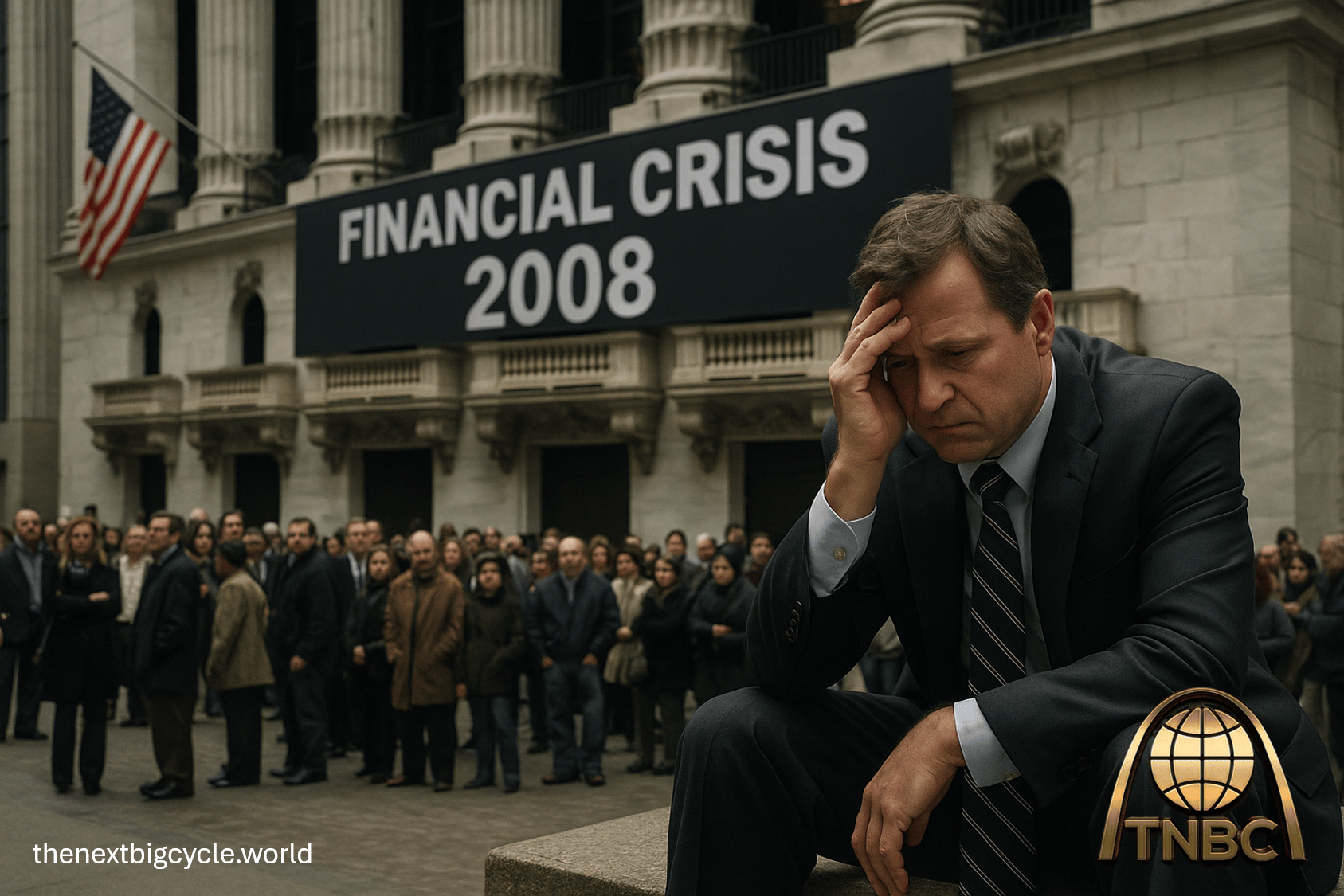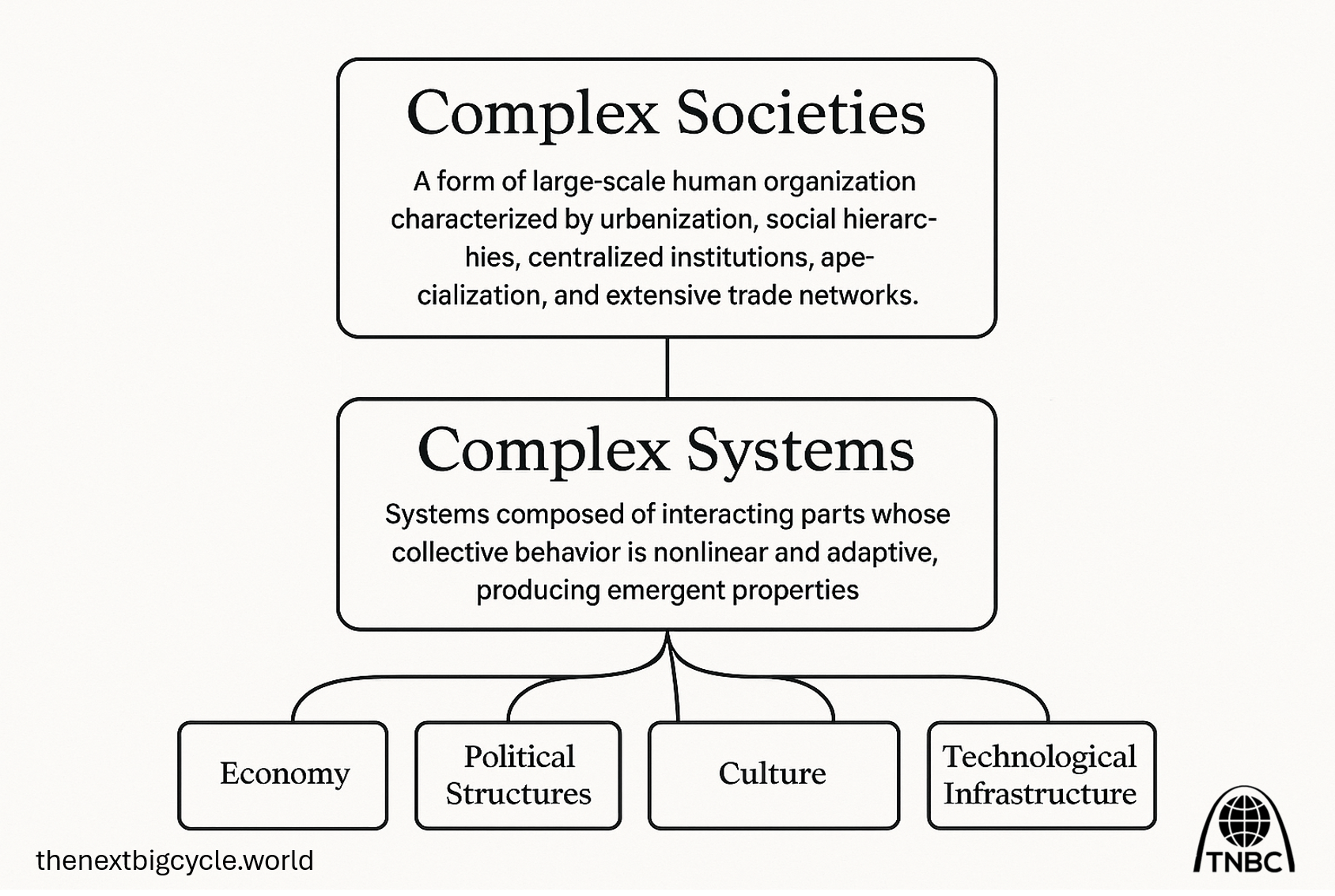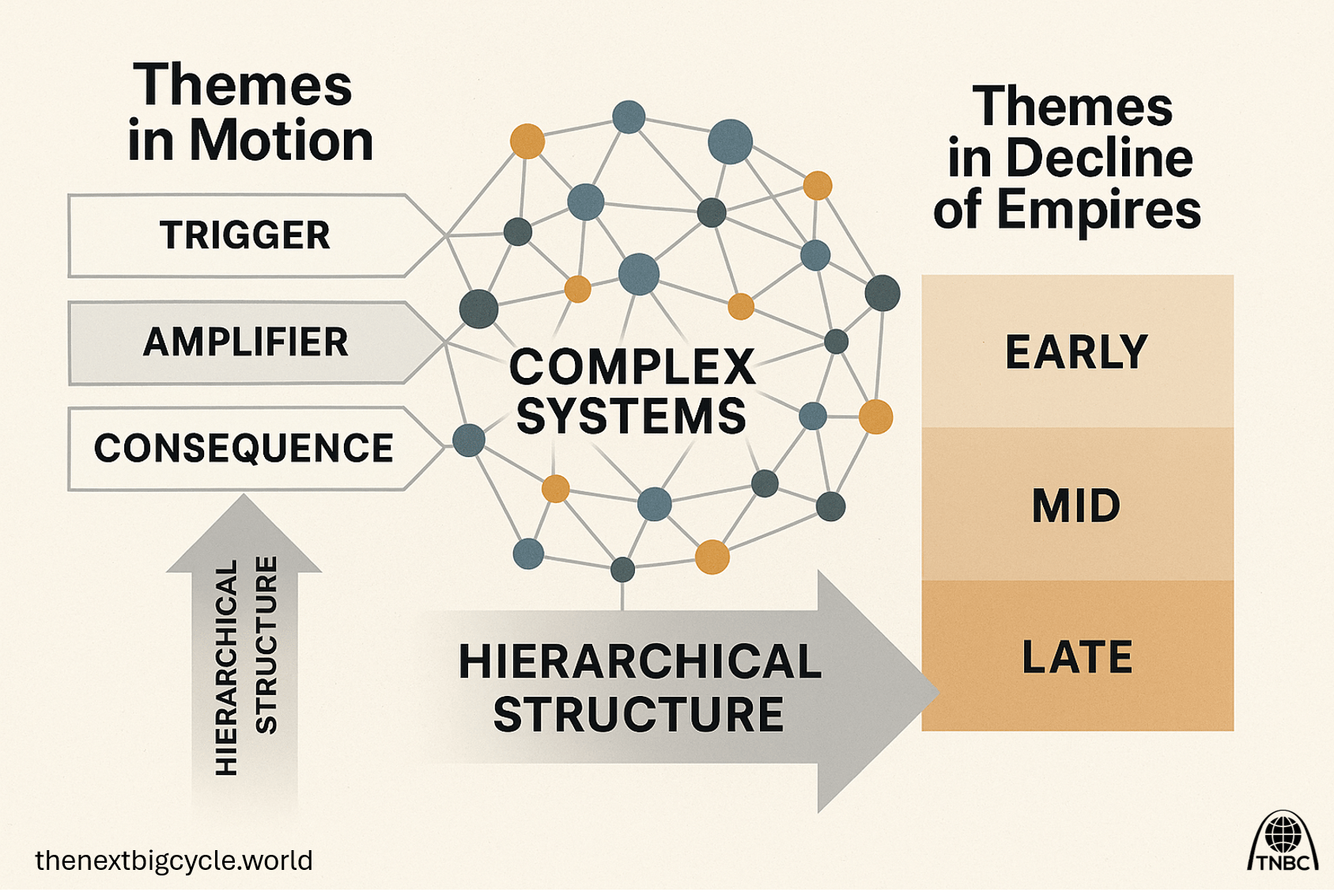
About this Series
In the series Turning Themes, we explore the overarching forces that shape our world -economic, political, social, and technological. Each entry examines how these broad themes interact in cycles, driving the rise, decline, and transformation of civilizations.
Why Do We Take What We Rely On for Granted?
Nothing lasts forever, right? We can agree on that. But what does this mean for the world around us? Complex societies are built on complex systems - economic, political, social, and technological. Are we blinded by their apparent stability? Could the very systems we trust be in their final act, and we just haven’t noticed? It’s time to ask: Are we ready for the great dysfunction that’s already underway?
In future articles, we will apply this theme more extensively to specific topics that were only briefly mentioned in this article, where we will further clarify the concept.

It’s time to ask: Are we ready for the great dysfunction that’s already underway?
What Does Systemic Dysfunction Really Mean?
At first glance, systems seem stable. We wake up every day to the same financial markets, the same political systems, and the same technology that powers our societies. These systems function as the invisible frameworks upon which our daily lives depend. We take them for granted because, on the surface, they appear unshakable - but beneath the surface, a different story unfolds. The truth is, every system - whether economic, political, social, or technological - has a natural life cycle. They grow, evolve, and eventually begin to dysfunction. But how can we recognize the signs of dysfunction, especially when the process is so slow and often imperceptible?
At its core, systemic dysfunction is the process by which the interconnected structures that support our societies begin to weaken, malfunction, or break down. It’s not an immediate collapse; it's a gradual erosion that often goes unnoticed until the damage becomes undeniable. Imagine a fraying rope that, over time, loses its strength. It may still hold things together for a while, but each strand is slowly coming apart. Similarly, systems that seem secure are often quietly deteriorating from within, driven by internal contradictions, inefficiencies, or external pressures.
Understanding systemic dysfunction means looking beyond the surface and asking uncomfortable questions: Why are systems that seem so stable sometimes so fragile? Why do we only react when the consequences of breakdowns are unavoidable? The challenge lies in identifying the early signs of systemic distress. These early signals are often dismissed or ignored - after all, systems are supposed to be stable, right? But that’s exactly why we need to pay attention. The longer we ignore the cracks, the more difficult it becomes to repair or mitigate the damage.

The global financial crisis – a systemic dysfunction
Consider the financial systems that dominate the global economy. They appear robust, built upon decades of institutional trust, regulations, and technological advancements. Yet, history tells us that these systems are prone to cycles of boom and bust. The 2008 global financial crisis wasn’t a sudden shock; it was the result of a series of accumulating weaknesses that finally gave way. Long before the crash, warnings were ignored, and the warning signs of a dysfunctional financial system were overlooked. Institutions that were considered too big to fail crumbled under the weight of systemic instability.
The same is true for political systems. How many times have we seen governments, once powerful and stable, collapse under the weight of corruption, economic mismanagement, or civil unrest? Nations rise and fall, often with little warning, and the process is rarely abrupt. The fall of the Soviet Union was the result of years of systemic dysfunction. The system appeared stable until it didn’t. By the time the collapse was evident, the cracks in the foundation had been visible for years, but they were ignored until the dysfunction reached a point of no return.
In every case, the warning signs of systemic dysfunction are present, but they’re often dismissed as temporary issues or anomalies. Perhaps they’re seen as isolated problems that won’t affect the larger system. But as these isolated issues accumulate, they lead to a broader systemic failure. Whether it’s in the financial markets, political governance, or social institutions, ignoring the dysfunction forces at play can result in catastrophic consequences.
The essence of systemic dysfunction is about recognizing that nothing is permanent. Systems are born, they grow, and eventually, they decay. We need to be aware of this cycle and learn to spot the early warning signs before they evolve into larger, uncontrollable crises. It’s about understanding the fragility that underpins the apparent stability of our institutions and preparing for the inevitable changes that will come.

Complex societies and complex systems
Systemic Dysfunction in the TNBC Two-Way Framework
In the TNBC Two-way Framework, Systemic Dysfunction plays a crucial role as an early-stage dynamic that sets the stage for broader societal collapse. It operates within the framework’s dual structure, integrating both the functional lens (Trigger → Amplifier → Consequence) and the thematic hierarchy of domain-based themes. This provides a comprehensive view of how dysfunction unfolds and what it means for the broader trajectory of global systems.

TNBC Two-way Framework - both the functional lens as the thematic hierarchy
Systemic Dysfunction is not just an isolated trigger or amplifier; it is the mechanism through which destabilization occurs. While it may begin subtly, its growing presence amplifies the challenges within a system, leading to more visible dysfunction over time. In the TNBC framework, it functions as both a trigger (setting the decline in motion) and an amplifier (exacerbating the effects of other destabilizing forces).
Examples of Systemic Dysfunction as Trigger and Amplifier:
Economic Dysfunction: Debt accumulation, inflation, and currency instability act as both triggers and amplifiers of financial instability, often leading to recessions or even depressions.
Institutional Dysfunction: The decay of institutions due to corruption and inefficiency can trigger political instability and amplify social discontent.
Social Dysfunction: Increasing inequality and societal fragmentation act as amplifiers, intensifying the effects of economic and political dysfunction.
2. Thematic Placement: Structural Forces Behind Systemic Dysfunction
In the TNBC Two-way Framework, Systemic Dysfunction is closely tied to several foundational forces that act as the structural backdrop to systemic decline. It represents a macro-theme, often resulting from the intersection of various dysfunctions across domains.
Key Themes Leading to Systemic Dysfunction:
Debt and Monetary Policy: Unsustainable debt, financial instability, and inflation are core drivers of economic dysfunction.
Institutional Decay: Loss of legitimacy, corruption, and inefficiency in governance structures lead to institutional dysfunction.
Social Fracturing: Inequality, loss of social mobility, and societal fragmentation amplify the effects of dysfunction.
Geopolitical Pressures: External stressors such as wars, trade disputes, and resource shortages exacerbate internal dysfunction.
In this way, Systemic Dysfunction is not an isolated issue but a cumulative force that draws from multiple thematic sources.
3. Temporal Layer: Early to Mid-Stage Decline
Systemic Dysfunction occurs in the early to mid-stage of systemic decline. It marks a shift from stability to instability across systems. Though the system is still operational at this stage, dysfunction sets in motion the forces that will eventually lead to collapse. While recovery is still possible, the damage done by systemic dysfunction makes it increasingly difficult to restore stability.
Signs of Early and Mid-Stage Decline:
Loss of Effectiveness: Key systems begin to operate less effectively, resulting in delayed or inadequate responses to emerging crises.
Erosion of Public Confidence: As institutions fail to deliver, public trust in government, finance, and social structures erodes, leading to political instability.
Increasing Inequality: As dysfunction grows, wealth gaps and social inequalities widen, leading to greater societal unrest.
4. Consequences: Systemic Breakdown and Path to Unraveling
The consequences of Systemic Dysfunction are far-reaching and often irreversible without major transformation. Although dysfunction itself is a gradual process, its cumulative effects eventually lead to the complete breakdown of systems, marking the transition to Systemic Unraveling.
Consequences of Systemic Dysfunction:
Institutional Distrust: The failure of institutions leads to a crisis of legitimacy, where public confidence is lost across key systems.
Erosion of Rule of Law: Legal frameworks break down, leading to arbitrary enforcement and further instability.
Rise of Radical Leadership: As governance falters, populist or authoritarian leaders may seize power, further amplifying systemic dysfunction.
Internal Conflict: Political, social, and economic dysfunction can lead to civil unrest, creating a fractured society.
These consequences signal the irreversible breakdown of systems, marking the point where dysfunction has fully taken hold.
Conclusion: Systemic Unraveling as a Phase of Convergence
In summary, Systemic Unraveling in the TNBC Two-way Framework functions as both a consequence and a marker of collapse. It’s the point at which previously emerging signs of dysfunction - such as institutional decay, societal fractures, and geopolitical pressures - converge into a complete systemic breakdown.
Rather than being a single cause or event, Systemic Unraveling is a late-stage phase that signals the final act of convergence, when multiple systems fail simultaneously. It is the lived experience of collapse, often irreversible without major transformation. As such, it serves as a narrative bridge - highlighting the end of one phase of the world order while signaling the potential for rebirth or transformation.